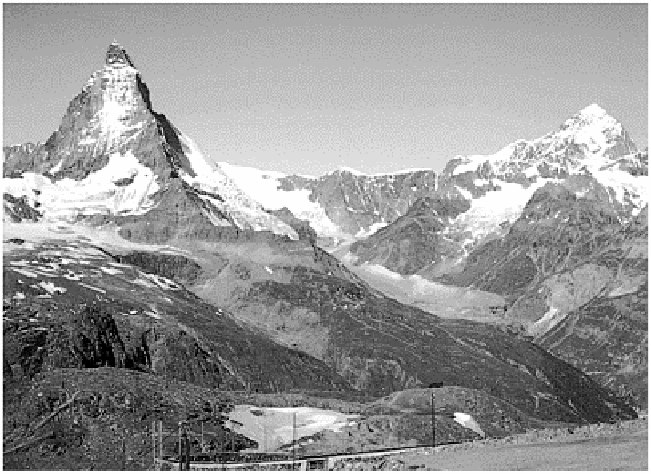Environmental Engineering Reference
In-Depth Information
Plate 25.6
A typical alpine landsystem in the Zermatt region
of Switzerland, with the Matterhorn (4478 m) to the left.
Photo: Ken Addison.
The cryonival belt is found in all alpine mountains, irrespective of whether they have a
permanent snowline and/or glaciers. Geomorphic processes are driven by short-term
(diurnal/seasonal) mass and energy budgets of the snowpack and ground ice. Nivation
concentrates frost, cold-chemical weathering and associated debris transport under and
around permanent and semi-permanent snow beds. These processes are especially active
around their lower margins, in meltwater percolation and wet snow zones and during the
ablation season. On low to moderate angle slopes they may erode shallow basins which
feed debris fans or terraces through melt chutes or by solifluction. Debris shed by frost
weathering, from rock walls overlooking snow beds, slides over their surface to form a
protalus rampart
at their foot (Plate 25.7). Snowpack itself may move as slush
avalanches during late-season melting, and more general avalanching from snowfields is
a significant geomorphic agent, especially where avalanches incorporate rock debris and
are focused in avalanche chutes.
Permafrost activity in the cryonival belt is
continuous
only on the highest summits and
should be regarded as
sporadic
elsewhere, dependent on and contributing to local factors
in the geoecological mosaic. Frost weathering plays a dominant role in eroding summit
crests, producing sharp
aiguilles
,
tors
and residual
blockfields
as intermediate stages in
the gradual
altiplanation
of alpine summits (Plate 25.8). Seasonal supplies of frost-
weathered products form
stratified screes
below rock walls. Cryoturbation reworks
mountain-top debris on broad summits into patterned ground and contributes to
downslope movement in both areas. It is often more effective on rockwall-foot talus

